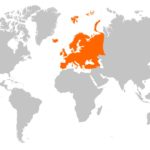Germany’s online retail market is back on a growth trajectory. After a period of relative stagnation following the pandemic, the Handelsverband Deutschland (HDE) projects a renewed surge in e-commerce activity.
According to the HDE Online Monitor 2025, Germany’s online retail is expected to generate €92.4 billion euro in net sales next year, a 4% increase over 2024 figures. This resurgence is not only a sign of digital resilience but also a reflection of evolving consumer behaviors and structural shifts across sectors.
(Image Source: www.unsplash.com)
Germany’s online retail state: A strong recovery after stagnation
“After several weaker years, online retail is once again the clear growth engine for retail in Germany. Despite the overall unsatisfactory consumer sentiment, online retailers are managing to achieve significantly better sales than in the previous year,” said Stephan Tromp, Deputy Managing Director of the HDE (German Retail Federation) in the press release.
The HDE notes that the market already showed signs of recovery in 2024, growing by 3.8% to reach €88.8 billion in net sales. While modest compared to pandemic-era spikes, this increase is meaningful given the broader backdrop of restrained consumer confidence.
Importantly, this growth has been consistent across all retail sectors, indicating a more balanced and sustainable upward trend than in previous years.
FMCG and sector trends: Who’s driving the growth?
One of the most noteworthy trends in the latest report is the rise of Fast Moving Consumer Goods (FMCG) in the digital space. This category, which includes food, beverages, and personal care items, grew 7.3% year-over-year, a rate more than double the overall sector average. Its increasing online penetration signifies changing shopping habits, particularly in everyday essentials.
Other sectors also showed positive momentum:
- Health & wellness, home & living, and leisure & hobby sectors also reported modest yet steady growth, highlighting broader consumer demand beyond essentials;
- Fashion & accessories held the largest share of online retail at 23.2%, closely followed by consumer electronics (21.5%).
This sector-wide performance suggests that e-commerce is becoming an embedded habit across demographic and product categories, not just a pandemic-era trend.
Marketplaces remain dominant channels
Complementing sector growth is the continued dominance of online marketplaces, which now account for 57% of total e-commerce sales in Germany. These platforms, led by Amazon, Zalando, and eBay, provide consumers with convenience and variety, reinforcing their central role in retail strategy.
Amazon stands out with a 63% market share of Germany’s online retail, encompassing both direct and third-party marketplace transactions. The ease of use, logistical efficiency, and broad selection make marketplaces an increasingly preferred choice, especially for multi-brand and cross-category shopping.

The role of cross-border e-commerce
The rise of marketplaces has also made it easier for foreign-based retailers to gain market share in Germany. In 2024, an estimated €8.9 billion of e-commerce revenue came from non-EU sellers, representing 10% of the online market.
Among these, Shein has emerged as significant player. Its success is fueled by aggressive pricing and digital advertising, although concerns remain regarding product quality and consumer trust.
Mobile-first shopping is the new standard
The convenience of mobile technology continues to transform how consumers interact with online retail. In 2024, 66% of all e-commerce sales occurred on mobile devices, split nearly evenly between mobile websites and apps. With smartphones accounting for nearly €46.7 billion in revenue, retailers must optimize mobile UX to stay competitive.
This mobile dominance also aligns with increased usage of apps for shopping, especially in fashion and lifestyle categories where visual experience and seamless checkout processes are key.
Silver shoppers and spending power
Demographically, while the number of total online shoppers is growing slowly, spending among older age groups (55+) is rising steadily. These consumers are becoming more digitally adept, and their average order value is increasing.
In 2024:
- The over-55 segment grew 1.4%, outpacing the general population’s 0.9% growth;
- The average German online shopper made 35.1 orders annually;
- Each order averaged €51.9.
This trend highlights the importance of accessibility and trust-building in online platforms, especially as older consumers bring higher spending capacity.
Sustainability and second-hand growth
Sustainability remains a significant undercurrent in the online retail narrative. The second-hand online market reached €9.9 billion in 2024, with strong performance in fashion, books, and electronics. The online resale of clothing and accessories alone now represents nearly 17% of category sales, underlining how consumers are aligning purchase behavior with environmental values.
Retailers tapping into this trend benefit not just from new revenue streams but also from strengthened brand loyalty among eco-conscious consumers.
AI and technology reshaping retail strategy
Retailers are increasingly turning to artificial intelligence (AI) to refine operations and improve customer experience. The 2025 HDE report shows significant adoption of AI for tasks such as:
- Article text generation
- Customer sentiment analysis
- Inventory and logistics forecasting
- Personalized pricing and offers
Most AI implementations are concentrated in marketing, IT, and supply chain management—areas where automation delivers measurable ROI and operational agility.
The outlook for 2025 and beyond
The forecast of €92.4 billion in online sales for 2025 confirms that Germany’s digital retail sector is not just recovering but thriving. From grocery and electronics to sustainability and senior shoppers, the e-commerce ecosystem is broadening its scope and solidifying its relevance.
With robust mobile usage, sector-wide gains, and technological innovation steering the way, Germany’s online retail sector is entering a new era of stability and maturity. Retailers that embrace omni-channel strategies, invest in AI, and prioritize customer experience are poised to lead in the years ahead.
***




